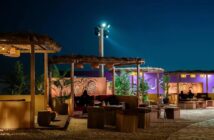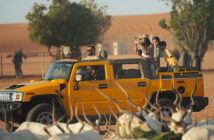By Reina Tejano-Berina
Over the vast Arabian desert lands, amidst the towering sandstone mountains, a peaceful message is whispered in the air: Welcome to Al-’Ula.
After years of hard work and preparation, the Winter at Tantora Festival has finally opened its ancient doors to travelers under the patronage of the Royal Commission of Al-‘Ula last December 2018. The buzz about the event is highly justified, from the long list of exciting excursions and scheduled concert performances of world-class artists to the glass mirror concert hall that’s been constructed right in the middle of the desert. It promised to be a “festival for all the senses” – for one to be entertained, inspired and to learn something new about Saudi Arabia.
Al-‘Ula is one of the seven governorates of the Medina region. It was once home to the Dedanite and Nabatean civilizations, included in the vital trading route between cities for commerce and development. Today, it is home to Saudi Arabia’s first UNESCO World Heritage Site: Madain Saleh. With the establishment of the glamorous Winter at Tantora Festival, Al-‘Ula is set to become a major tourist destination in the Kingdom in the years to come.



Our three-day adventure began by arriving at Al-‘Ula via Saudia Airlines, which was the exclusive airline partner of the festival, with direct flights from Jeddah and Riyadh. The welcoming party at the Prince Majeed bin Abdulaziz Airport had friendly, young Saudi ushers, all well-versed in English and attending to guests with a smile. Once the confirmation of registration was done, we walked out of the airport and were met with a long formation of numbered SUVs assigned to each visitor. Impressive, was the first word that came to mind.
The drive from the airport to the resort gave us a sneak peek of the weekend ahead, cruising past rock formations that were as silent as they were majestic. We then arrived to our “glamp-site” called Shaden Resorts. From the outside, they all appeared to be traditional Arabic tents in between huge rock mountains, but inside, it had all the amenities you needed: air-conditioning, hot shower, a Nespresso machine and more. We were about to experience “glamping” (glamorous camping) at its finest.
Our exploration of Al-‘Ula officially started at Dadan Kingdom, one of the ancient civilizations of the Arabian Peninsula. It is a city that is now underground, but once flourished as an important colony in the 6th and 7th century. By late afternoon, we were brought to the iconic site of the Elephant Rock and were made to admire its glory until sunset fell. A seating area with traditional coffee and Arabic music allowed us to spend more time viewing the enormous rock formation that looks like an elephant grazing through the desert. As the stars began to come out, the sight became more breathtaking by the minute.
To cap off our first night, we ended it with a stroll along the old town of Al-‘Ula. The “souk” showcased local craftsmanship and goods, including specialty oils and calligraphy. We also found the “Tantora” (sundial) of which the event is named after. For years, it was the local’s way of telling time and seasons.
Day 2 began with a trip to Al Hijr, filled with remarkably preserved, man-made tombs of Nabateans that depicted modern-day accuracy and skill. To think that these men made these grandiose structures with nothing but a chisel, hammer and picks is beyond belief. The tomb of all tombs was the Qasir Al Farid, the most photographed tomb of Madain Saleh. Interestingly enough, this sought-after site in Al-Ula is in fact, an unfinished tomb and no one ended up being buried there. Nowadays, people sojourn more than a thousand miles just to take a photo of this piece of history.


We also stopped by Jabal Al Ikmah (Library Mountain), where ancient inscriptions were found on every rock around us. It showed familiar symbols of animals and writings from the Dadanite and Lihyanite era. I run my hands through the carved details of the rock and couldn’t help but feel that I have touched a piece of history. For lunch, we were driven up to the highest point in Al-‘Ula called Harrat Owairdh. They have transformed this mountain-top to a relaxing, viewing deck that overlooks the entire Al-‘Ula county.
Come evening time, guests from the entire Tantora Festival dressed to the nines to attend the concert of internationally acclaimed composer and musician, Omar Al-Khairat. Everyone convened at the Marayah Theater, all amazed with the construction and beauty of this “glass hall”. As we wait for the concert to commence, we were led to a short, immersive art exhibit of Vincent Van Gogh. His famous works were virtualized and directed to move and in such a way that were both poetic and sensorial. It felt like you were in the paintings yourself, whether in the field of sunflowers or under a starry, starry night. Later on at the concert, the audience enjoyed the classic pieces of Omar Al-Khairat, clapping and jesting along his music for almost two hours. He was met with multiple standing ovations until his last performance of the night. Other artists like Andrea Bocelli, Lang Lang, and Yanni were also booked for the Winter at Tantora weekends.


On our third and final day, our excursions included a thrilling sand buggy ride that had us fiercely maneuvering up and down the sand dunes and in between rock mountains. Half an hour later, it was followed by a gripping ride up a helicopter for an aerial tour, giving us a different perspective of AlGarameel, Akra Mountain, the Circle and Arrow, Al Hijr, Elephant Rock and of course, Qasir Al-Farid. Our final meal for the trip was set at a hidden location between large rocks where the family restaurant of Shalal Farm mysteriously sits. We had to navigate our way through a cave-like entrance only to find a boisterous setup at the end of the passageway where guests were seated in Arabic style, traditional instruments being played in the center and a grill ready at each table for us to roast local corn and chestnuts on. We gathered with our group of other tourists, many of them first-timers to the Kingdom.
“We did not know that there was such history and beauty here in Saudi Arabia,” said one of the guests. It is that feedback and from many others too, that proved the success of the festival’s goal: to discover a place like no other. Overall, the weekend package was a balanced selection of sightseeing, cultural immersion and adventures. The Saudi tour guides were all knowledgeable, enthusiastic and engaging, in fact, they were the ones who impressed us the most. This event has shown the potential that the Kingdom has in making its mark as a tourist destination and this is only the beginning.
As of writing, the highly-anticipated highlight of the event is the inauguration of the Custodian of the Two Holy Mosques Endurance Cup, which is the horse race of Arabian stallions from Saudi Arabia, UAE, Bahrain and other countries. It will also kick off the week-long Al-‘Ula Balloon Festival called “Tethered Flight and Night Glow Show” providing a hot air balloon experience from sunset to evening from February 1 to 9.
The Winter at Tantora Festival recently announced that it has now been extended until February 23, featuring selected Arab artists including Kadim Al-Saher and Rashed Al-Majed.
For more information/bookings, visit www.winterattantora.com




